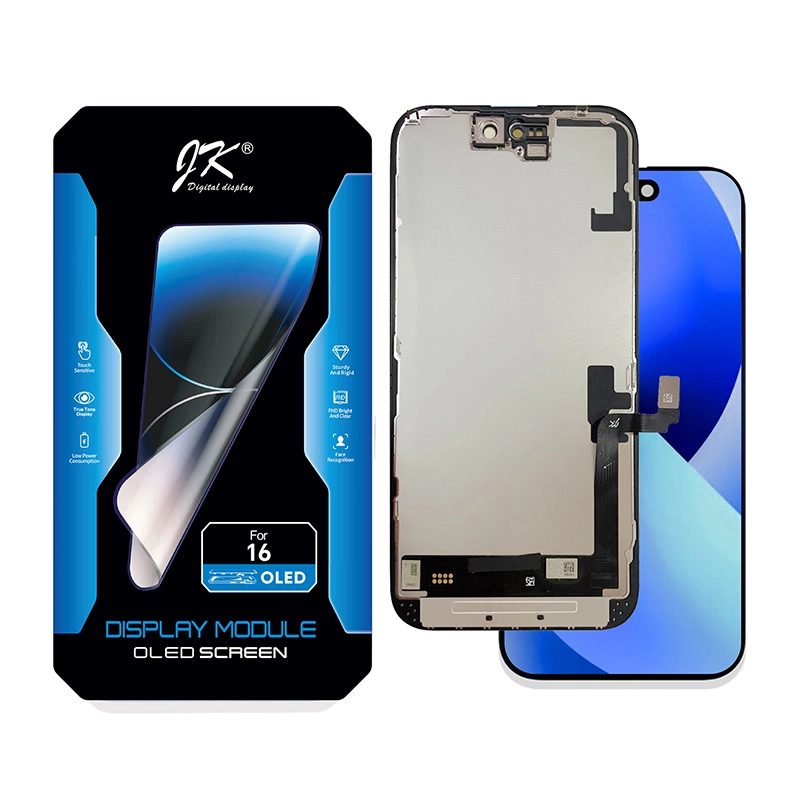Repairing the iPhone 16 is more than just swapping a broken screen. Hidden within the precision-engineered OLED display are micron-level tolerances that dictate whether a replacement succeeds or fails. Small deviations in screen thickness, connector placement, touch panel alignment, or adhesive distribution can trigger a chain reaction of problems—dead pixels, color shifts, unresponsive touch, or edge lifting—that may compromise the repair quality and long-term device reliability.
Kelai (brand: JK), a leading manufacturer of smartphone LCD and OLED modules in China, provides high-precision aftermarket iPhone 16 OLED screens. Designed with strict tolerance control, these modules allow repair shops to achieve near-OEM performance, reduce installation risk, and maintain customer satisfaction.
This guide explores the critical role of manufacturing tolerances in iPhone 16 OLED repairs, illustrating why even minor variations matter and offering practical advice for professional repair operations.
Repair shops often encounter recurring issues after replacing iPhone OLED screens:
Touch inconsistencies where multi-finger gestures fail or ghost touches appear.
Visual anomalies such as uneven brightness, color shifts, or backlight leakage.
Mechanical issues like screen lift, frame stress, or connector damage.
While these problems are often blamed on “low-quality aftermarket screens,” many are actually rooted in manufacturing tolerances. Understanding which dimensions and alignments matter—and why—is the first step toward consistently successful repairs.
Every component of the iPhone 16 OLED screen is engineered with tight tolerances:
Screen Thickness: Variations of ±0.05 mm can impact frame alignment, cause uneven pressure distribution, and lead to screen lift or micro-cracks.
Connector Placement: Deviations as small as 0.02–0.03 mm may result in intermittent touch or display failure.
Touch Panel (TP) Alignment: Metal mesh TP structures require precise positioning to maintain multi-touch accuracy and haptic responsiveness.
Adhesive Distribution: Uneven adhesive can create weak spots, increasing the risk of screen detachment over time.
Panel Curvature and Flexibility: Slight bending is inherent to OLED panels; incorrect curvature can stress the device chassis or pixels.
Kelai (JK) ensures all components meet strict tolerances, maintaining optimal fit and function for the 6.1-inch OLED screen with 1179×2556 resolution, 800±50 cd/m² brightness, 100000:1 contrast ratio, NTSC 103%, 6600K color temperature, and all-angle viewing.

The effects of tolerance deviations often amplify once the screen is installed:
Minor misalignment in the TP → Dead zones or ghost touches → Customer complaints.
Uneven adhesive thickness → Edge lifting → Exposure to dust and moisture → Reduced longevity.
Thickness variations → Stress on frame → Microfractures in OLED panel → Premature failure.
Connector misplacement → Loose contact → Flickering, delayed response, or total touch loss.
Understanding these cause-and-effect relationships enables repair technicians to anticipate issues before installation, rather than reacting after device failure.
Even high-precision components can fail if installation is careless. Repair professionals must integrate tolerance awareness into every step:
Pre-Installation Checks: Verify panel flatness, connector alignment, and adhesive distribution.
Precision Tools: Utilize alignment jigs, calibrated presses, and anti-static mats to avoid pressure-induced damage.
Controlled Environment: Maintain recommended temperature and humidity for adhesive curing to prevent warping.
Touch Panel Calibration: Ensure True Tone, HDR, and adaptive brightness functions remain consistent post-installation.
Kelai (JK) aftermarket screens are engineered to minimize the risk of tolerance-related errors, allowing technicians to focus on precise installation rather than compensating for poor component quality.
Failing to respect manufacturing tolerances may not produce immediate problems, but it often results in long-term reliability issues:
Color Drift: Slight misalignment or uneven pixel density can cause subtle shifts in color reproduction over time.
Touch Degradation: Poor TP placement can lead to slowly worsening latency or unresponsive zones.
Structural Stress: Inaccurate thickness or curvature increases stress on the frame, potentially resulting in screen detachment or micro-cracking.
Warranty Risks: Frequent post-repair failures harm shop reputation and increase rework and compensation costs.
Professional repair shops prioritize tolerance-aware installation, reducing warranty claims and maintaining customer trust.
Selecting a supplier with tight tolerance control is crucial for professional repair operations. Key considerations include:
Batch Consistency: Ensure every module adheres to the same thickness, TP alignment, and adhesive uniformity.
Inspection Documentation: Supplier-provided QC reports and tolerance charts help technicians verify each screen.
Aftermarket Calibration: Premium providers like Kelai offer pre-calibrated modules, reducing setup time and installation errors.
Technical Support: Suppliers with engineering expertise assist in resolving edge cases or challenging installations.
Investing in high-precision aftermarket modules is a strategic decision that safeguards repair quality and shop efficiency.
Use Micrometer Tools: Measure panel thickness to ensure consistency with device chassis.
Check Connector Alignment: Ensure all pins and flex cables are properly seated to prevent intermittent touch issues.
Maintain Installation Logs: Record batch numbers and key tolerance measurements for quality control.
Monitor Adhesive Performance: Use consistent curing protocols to maintain structural integrity.
Train Technicians: Emphasize the importance of tolerance awareness during every repair step.
Tip: Incorporating Kelai (JK) high-tolerance modules reduces the likelihood of post-installation failures, allowing technicians to focus on installation precision rather than component variability.
Manufacturing tolerances are the hidden variable that dictates repair success for iPhone 16 OLED screens. Small deviations in thickness, connector alignment, or TP placement can have outsized effects on touch performance, visual fidelity, and long-term durability.
By choosing high-precision aftermarket screens like Kelai (JK) and integrating tolerance-aware repair practices, professional repair shops can:
Deliver consistent, near-OEM repair quality
Minimize touch and display anomalies
Extend the service life of repaired devices
Reduce warranty claims and operational inefficiencies
For repair shops committed to precision, tolerance awareness is not optional—it’s the cornerstone of professional-grade repair.